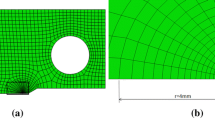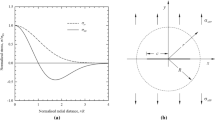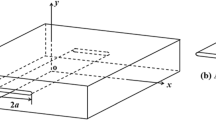Abstract
A comparison between the three-dimensional experimental and numerical displacement fields surrounding a notch/crack in a ductile 4340 steel tested in three-point bending is presented. Excellent agreement between computed and measured deformations exists at load levels below 50 to 75 percent of ultimate loads. Experimentally determined crack tunnel profiles are included in the finite element model through nodal release; the evidence of the crack tunnel appears in the displacements at the surface. It is shown that surface measurements of unloading reveal specimen-internal failure initiation in the form of tunneling. Out-of-plane deformations deviate from analytical values earlier than in-plane values; this observation compromises the accuracy with which predictions of in-plane crack tip variables can be made when they are based on measured out-of-plane deformations (caustics, gradient sensing) once significant plasticity arises. Comparison is made between J-integral values calculated from the external boundary conditions and from a domain integral. The tunneling tests provide a method of estimating a critical value of J. The stress intensity factor governs the deformation in the elastic regime, but, because of the finite notch- tip radius underlying the experimental configuration, the HRR field does not describe the deformation well under plastic conditions. Comparison of numerical simulations with and without tunneling provide insight into criteria that could be used to implement an implicit crack propagation scheme into the numerical model.
Similar content being viewed by others
References
ASTM E 813–81 (1982). Standard test method for JIc, A measure of fracture toughness. Annual Book of ASTM Standards, Part 10, 822–840.
Atkins, A.G. and Mai, Y.-W. (1988). Elastic and Plastic Fracture Metals, Polymers, Ceramics, Composites, Biological Materials, Ellis Horwood Limited, Chichester.
Bridgman, P.W. (1944). The stress distribution at the neck of a tension specimen. Transaction of the American Society of Metals 32, 553–574.
Bridgman, P.W. (1952). Studies in Large Plastic Flow and Fracture, Metallurgy and Metallurgical Engineering Series (Consulting Editor R.F. Mehl), McGraw-Hill Book Company, Inc., New York.
Broek, D. (1974). Elementary Engineering Fracture Mechanics, Noordhoff International Publishing, Leyden.
Bucci, R.J., Paris, P.C., Landes, J.D. and Rice, J.R. (1972). J-integral estimation procedures. Fracture Toughness, Proceedings of the 1971 National Symposium on Fracture Mechanics, Part II, ASTM Special Technical Publication 514, 40–69.
Gurson, A.L. (1977). Continuum theory of ductile rupture by void nucleation and growth Part I-yield criteria and flow rules for porous ductile media. Journal of Engineering Materials and Technology 99, 2–15.
Hertzberg, R.W. (1989). Deformation and Fracture Mechanics of Engineering Materials, Third Edition, John Wiley and Sons, New York.
Hutchinson, J.W. (1968a). Singular behavior at the end of a tensile crack in a hardening material. Journal of Mechanics and Physics of Solids 16, 13–31.
Hutchinson, J.W. (1968b). Plastic stresses and strain fields at a crack tip. Journal of Mechanics and Physics of Solids 16, 337–347.
Kachanov, L.M. (1971). Foundations of the Theory of Plasticity, North-Holland Publishing Company, Amsterdam.
McMeeking, R.M. (1977). Finite deformation analysis of crack-tip opening in elastic-plastic materials and implications for farcture. Journal of Mechanics and Physics of Solids 25, 357–381.
Narasimhan, R., Rosakis, A.J. and Moran, B. (1992). A three-dimensional numerical investigation of fracture initiation by ductile failure mechanisms in a 4340 steel. International Journal of Farcture 56, 1–24.
Pfaff, R.D. (1991). Three-Dimensional Effects in Nonlinear Fracture Explored with Interferometry, Ph.D. Thesis, California Institute of Technology, Pasadena, California.
Rice, J.R. (1968a). A path independent integral and the approximate analysis of strain concentration by notches and cracks. Journal of Applied Mechanics 35, 379–386.
Rice, J.R. (1968b). Mathematical analysis in the mechanics of fracture. Fracture, An Advanced Treatise. (Edited by H. Liebowitz) Volume II, Mathematical Fundamentals, Academic Press, New York, 191–311.
Rice, J.R. and Johnson, M.A. (1970). The role of large crack tip geometry changes in plane strain fracture. Inelastic Behavior of Solids. (Edited by M.F. Kanninen, W.F. Adler, A.R. Rosenfield, R.I. Jaffe) McGraw-Hill, New York, 641–672.
Rice, J.R. and Rosengren, G.F. (1968). Plane strain deformation near a crack tip in a power-law hardening material. Journal of Mechanics and Physics of Solids 16, 1–12.
Rice, J.R., Paris, P.C. and Merkle, J.G. (1973). Some further results of J-integral analysis and estimates. Progress in Flaw Growth and Fracture Toughness Testing, ASTM Special Technical Publication 536, 231–245.
Schultheisz, C.R. (1991a). Comparison of Experimental and Computational Crack-Tip Deformations Using Moiré Interferometry and Finite Elements, PhD. Thesis, SM Report 91–1, California Institute of Technology Report, Pasadena.
Schultheisz, C.R. (1991b). Comparison of Numerical and Analytical Crack-tip Deformations, SM Report 91–2, California Institute of Technology Report, Pasadena.
Schultheisz, C.R., Pfaff, R.D. and Knauss, W.G. (1998a). An experimental/analytical comparison of three-dimensional deformations at the tip of a crack in a plastically deforming plate I. Optical interferometry and experimental preliminaries, this issue, pp. 1–25.
Schultheisz, C.R., Pfaff, R.D. and Knauss, W.G. (1998b). An experimental/analytical comparison of three-dimensional deformations at the tip of a crack in a plastically deforming plate II. Material characterization and finite element analysis, this issue, pp. 27–46.
Shih, C.F. (1983). Tables of Hutchinson-Rice-Rosengren Singular Field Quantities, MRL E-147, Materials Research Laboratory Report, Brown University, Providence.
Shih, C.F. and German, M.D. (1981). Requirements for a one parameter characterization of crack tip fields by the HRR singularity. International Journal of Fracture 17, 27–43.
Tada, H., Paris, P.C. and Irwin, G.R. (1973). The Stress Analysis of Cracks Handbook, Del Reserach Corporation, Hellertown, Pennsylvania.
Williams, M.L. (1957). On the stress distribution at the base of a stationary crack. Journal of Applied Mechanics 24, 109–114.
Author information
Authors and Affiliations
Rights and permissions
About this article
Cite this article
Schultheisz, C., Pfaff, R. & Knauss, W. An Experimental/Analytical Compression of Three-Dimentional Deformations at the Tip of a Crack in a Plastically deforming Plate III: Material Characterization and finite element analysis. International Journal of Fracture 90, 47–81 (1998). https://doi.org/10.1023/A:1007455804995
Issue Date:
DOI: https://doi.org/10.1023/A:1007455804995




